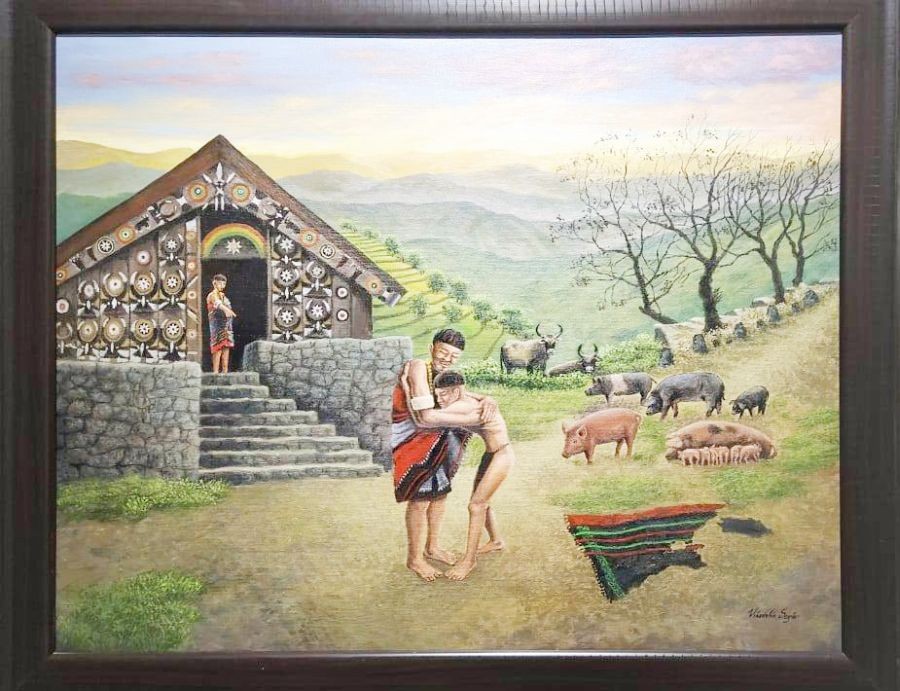‘The Prodigal Son painting’ by Mhao Aaron Odyuo, a Kohima-based multi-media artist displayed at ‘Naga Ancestral Voices’ exhibition held at The Highland Institute, Kohima. Two of his works are part of the exhibition namely ‘Bullroarer sculpture’ and ‘The Prodigal Son painting.’ (Morung Photo)

Morung Express News
Kohima | April 23
“How do Nagas react to the recordings that JH Hutton made over a hundred years ago? Can they tell us something about the songs and their meaning? Or has the music lost its relevance to today’s performers and listeners?”
With these questions in mind, Ethnomusicologist Dr Christian Poske brought digital copies of the recordings to Nagaland in February this year.
Speaking on ‘Recirculating JH Hutton’s Cylinder Recordings in Nagaland’ at the Exhibition opening of ‘Naga Ancestral Voices’ at The Highland Institute, Kohima, Dr Christian Poske, SOAS University of London remarked that the recordings are part of the intangible cultural heritage of Nagaland and that “communities have been disconnected from the recordings for over a century.”
Dr Poske underscored that “although the digital recordings have been accessible online on the website of the Pitt Rivers Museum since 2012, not many people know about the recordings in Nagaland.”
The recordings, he highlighted, “are so far not accessible at archives in India nor more specifically in Nagaland where they are of interest to Naga communities and researchers.” He said most of Hutton's cylinder recordings lack essential information like date and place of recording. “Often, he only wrote down the title or performance context of a song on the cylinder inlays and sometimes, he noted down the song lyrics or the first names of performers,” he added. He further stated that “community members can provide further information on the content and context of the recordings.”
John Henry Hutton (1885-1968) was a British administrator and anthropologist who worked for the Indian Civil Service in the Naga Hills district of the Assam province, which incorporated the territory of Nagaland of present-day India. Hutton is said to have made 14 cylinder recordings of Angami, Sümi, Chang, Sangtam, and Lotha songs with a phonograph, probably the earliest audio documentation of Naga traditional music.
Although, he sent song transcriptions and notes with the cylinders to the Pitt Rivers Museum in Oxford, there is little known about the circumstances of the recordings. The first two cylinders broke during transport in 1915, but another twelve reached the Museum intact in 1919. Apart from the cylinders, the Museum also received many Naga artefacts, objects and field photographs from him as documentation of Naga culture.
The on-going exhibition also highlights that Hutton’s field notes and publications indicate that his dobashis (interpreters) were involved in some of his recordings: Vikhepu Ayemi (d.1919), village headman of Sürümi and four other Sümi interpreters sing together on cylinder no. 14 (track 12).
In Khonoma, Krusalie Sophi, a farmer, recognised the song “Losorüü” that Hutton had recorded on cylinder 3 (track 1) and sang a different version still known in the village. Heshevi Awomi, the niece of Vikhepu Ayemi, and his grandnephew Qheniho Jakhalu were astonished to hear the voice of their ancestor on cylinder 14 (track 12) in Sürümi (Zunheboto).
During the interviews conducted by Dr Christian Poske and Lanuakum Aier of The Highland Institute for the project, Heshevi had described how Hutton once saw Vikhepu on a building high above himself in one of his dreams because he was impressed with his personality. Hutton and Vikhepu are also said to have planted a tree to commemorate their friendship before Vikhepu died from the Spanish flu in 1919. The tree reportedly still stands in the village today.
The opening of the exhibition also featured an interview with Mhao Aaron Odyuo, a Kohima-based multi-media artist whose work is heavily influenced by Naga craft traditions. He trains aspiring artists at The Art Village in Kohima, and two of his works are also part of the exhibition namely “Bullroarer sculpture” and “The Prodigal Son painting.”
Another highlight of the event was a special performance by folk singer and musician and Padma Shri Guru Rewben Mashangva.
The first of its kind exhibition featuring historical sound recordings from Nagaland made between 1916 and 2010 and contemporary visual art by The Art Village, Kohima, will open till May 7, 2022 and visitors will get to hear a range of compelling recordings and also enjoy exciting contemporary complementary visual works by Mhao Aaron, The Art Village, Kohima, and multi-media artist Temsuyanger Longkumer.






